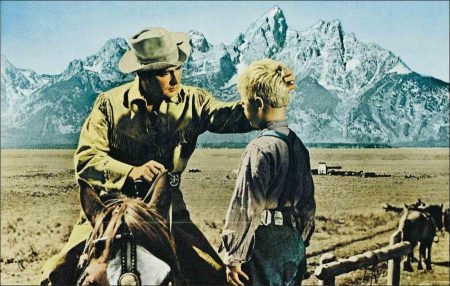Shane movie storyline. Enigmatic gunslinger Shane rides into a small Wyoming town with hopes of quietly settling down as a farmhand. Taking a job on homesteader Joe Starrett’s farm, Shane is drawn into a battle between the townsfolk and ruthless cattle baron Rufus Ryker. Shane’s growing attraction to Starrett’s wife, Marian, and his fondness for their son Joey, who idolizes Shane, force Shane to realize that he must thwart Ryker’s plan.
Shane (1953) is a timeless, classic western tale – a very familiar and highly regarded seminal western and the most successful Western of the 1950s. The film’s rich color cinematography captures the beautiful environment of the legendary frontier (filmed on location in Jackson Hole, Wyoming) with its gray-blue Grand Tetons as a backdrop.
The screenplay was based on Jack Schaefer’s successful 1949 book of the same name. The film received six Academy Awards nominations: Best Picture, Best Supporting Actor (Brandon de Wilde), Best Supporting Actor (Jack Palance), Best Director, Best Screenplay (by A. B. Guthrie, Jr.), and Best Color Cinematography, and won its sole Oscar award for photographer Loyal Griggs. Unbelievably, star Alan Ladd in probably his best known and realized performance, was un-nominated. Director/actor Clint Eastwood’s Pale Rider (1985) paid homage to Stevens’ film with a similar storyline.
Veteran director / producer George Stevens’ film is often considered the second film of his “American trilogy,” positioned between A Place in the Sun (1951) and Giant (1956). Stevens self-consciously fashioned this simple western into a wide-screen, Technicolored panoramic masterpiece to create a symbolic myth: the age-old story of the duel between good and evil, the advent of civilization (with families, law and order, and homesteaders) and progress into the wilderness (a world of roaming cattlemen, lawless gunslingers, and loners on horseback), a land-dispute conflict between a homesteader and cattle baron, and the coming of age of a young boy. The film is dotted with classic sequences – the uprooting of the stubborn stump in the yard, Torrey’s murder in the muddy street and his hilltop funeral, and the climactic finale.
About the Story
Shane (Alan Ladd), a skilled, laconic gunfighter with a mysterious past,[4] rides into an isolated valley in the sparsely settled Wyoming Territory, some time after the Civil War. At dinner with local rancher Joe Starrett (Van Heflin) and his wife Marian (Jean Arthur), he learns that a war of intimidation is being waged on the valley’s settlers. Though they have claimed their land legally under the Homestead Acts, a ruthless cattle baron, Rufus Ryker (Emile Meyer), has hired rogues and henchmen to harass them and drive them out of the valley. Starrett offers Shane a job, and he accepts.
At the town’s general store, Shane and other homesteaders are loading up supplies. Shane enters the saloon adjacent to the store, where Ryker’s men are drinking, and orders a soda pop for the Starretts’ son, Joey (Brandon deWilde). Chris Calloway (Ben Johnson), one of Ryker’s men, throws a shot of whiskey on Shane’s shirt. “Smell like a man!” he taunts. Shane doesn’t rise to the bait, and leaves to the taunts of Ryker’s men. On the next trip to town, Shane returns the empty soda bottle to the saloon, where Calloway again taunts him. Shane orders two shots of whiskey, pours one on Calloway’s shirt and throws the other in his face, then knocks him to the ground. A brawl ensues; Shane prevails, with Starrett’s help. Ryker declares that the next time they meet, “the air will be filled with gun smoke.”
Joey is drawn to Shane, and to his gun. Shane shows him how to wear a holster and demonstrates his shooting skills, but Marian interrupts the lesson. Guns, she says, are not going to be a part of her son’s life. Shane counters that a gun is a tool, no better nor worse than an axe or a shovel, and as good or bad as the man using it. Marian retorts that the valley would be better off without any guns—including Shane’s.
Shane (1953)
Directed by: George Stevens
Starring: Alan Ladd, Jean Arthur, Van Heflin, Brandon De Wilde, Jack Palance, Ben Johnson, Edgar Buchanan, Emile Meyer, Elisha Cook Jr., Douglas Spencer, John Dierkes, Ellen Corby, Edith Evanson
Screenplay by: A.B. Guthrie Jr.
Cinematography by: Loyal Griggs
Film Editing by: William Hornbeck, Tom McAdoo
Costume Design by: Edith Head
Set Decoration by: Emile Kuri
Art Direction by: Hal Pereira, Walter H. Tyler
Music by: Victor Young
Distributed by: Paramount Pictures
Release Date: April 23, 1953
Views: 270


